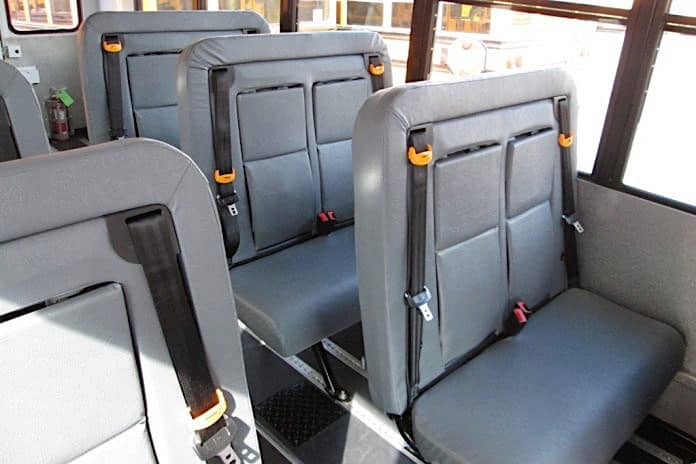The more things change, the more they stay the same. I was reminded of this saying during the proceedings of the School Bus Safety Working Group called by Ohio Gov. Mike DeWine following the Aug. 22 fatal ejection of a student during a school bus crash.
“There is always more that can be done when it comes to the safety of children, and I believe we have an obligation to take a holistic look at the safety of our school buses,” DeWine said in a statement announcing the deliberations. “This group’s review will be thorough, focusing on many different aspects of transportation safety.” And it did. The working group which commenced on Sept. 11 and completed its sixth meeting on Dec. 1 examined school bus driver training and qualifications, licensing, vehicle standards, and inspections. Even the response of emergency services to the school bus crash that started it all. But in the end, the exercise boiled down to lap/shoulder seatbelts.
How do they work? What are the unintended consequences? Should a law require them? By now, everyone knows how seatbelts work. For over 55 years, lap/shoulder belts have been required in the driver and front passenger seats of all passenger cars and trucks in the U.S. (and more recently for rear seats). Since 1985, all states have required parents, guardians and caregivers to buckle up children in car seats.
Yet so much remains either misunderstood about how seatbelts work in school buses and how students interact with them or simply obfuscated due to sheer opposition. Too often, the age-old arguments against school bus seatbelts have centered around issues that have been explained or even debunked. Let’s take the most safety-sensitive: emergency evacuations.
At the TSD Conference in November, attendees participating in the hands-on evacuation training of a 48-passenger Type C school bus filled with theater smoke to mimic a fire averaged an evacuation of 5 “students” dolls representing both students with disabilities and preschoolers in about two minutes. Research indicates a school bus can become completely engulfed in smoke if not flames in about two and a half minutes. Granted, there is not much time left over. But it is also important to note that each timed attendee physically removed each of the five “students,” making return trips as necessary. And there were no Good Samaritans to assist, as is often the case during a real-life emergency.
The seatbelt opponent points out that the time necessary was for only five students. What about 50? The seatbelt proponent asks what school bus in America has 50 students with disabilities on board at the same time? Not to say it’s impossible but it is highly unlikely. Add to that improbability 50 students in various degrees of securement beyond a lap/shoulder seat belt—i.e., wheelchairs, five-point safety vests, etc.
Regardless, no one would ever advocate that these students not wear child safety restraint systems simply because there is a risk they might burn to death in a fire or become trapped in an underwater submersion. Yet otherwise able-bodied students wearing simply a three point belt with a buckle that most kindergartners can successfully depress constitutes a tragedy in the making?
Now, take cost. Adding lap/shoulder belts to a new school bus purchase can run upward of $10,000. Oftentimes the price can be less for a smaller passenger capacity bus. Opponents argue that money can be better spent elsewhere. Yet fewer and fewer student transporters are batting an eyelash at increasing costs of the latest video surveillance technology, tablets, even air conditioning. All are valuable safety or operational enhancements, for sure. Why aren’t seatbelts viewed similarly? The National Transportation Safety Board has proof that three-point belts work in a crash, specifically in side-impact and rollover crashes where compartmentalization fails. There are also the experiences of school bus drivers to consider. They witness student behavior markedly improve when students buckle up. I could go on.
I will agree that a mandate is not necessarily the answer. Considering the school bus safety record, student transporters should make their own decisions on adopting seatbelts and not be forced by bureaucrats with no operational experience to dictate how to. But those decisions should be made using logic. If the ongoing cost is covered by the school district and/or voters, and the necessary safety training is given to bus drivers and students along with a sound usage policy, this industry owes it to their communities to make school buses as safe as possible. The Ohio recommendation comes out Jan. 8. Time will tell if things change.
Editor’s Note: As reprinted in the January 2024 issue of School Transportation News. The Ohio School Bus Working Group’s recommendations were delayed and ultimately released on Jan. 31.
Related: TSD Panelists Discuss Implications of Electric School Bus on Special Needs Service
Related: NAPT Asks Feds for Clarification on Benefits of School Bus Lap/Shoulder Seatbelts
Related: STN President Corpin Receives CSN Child Safety Advocate Award
Related: (STN Podcast E188) Onsite at the TSD Conference, Part 2/2: Contracting, Safety & Leadership
















